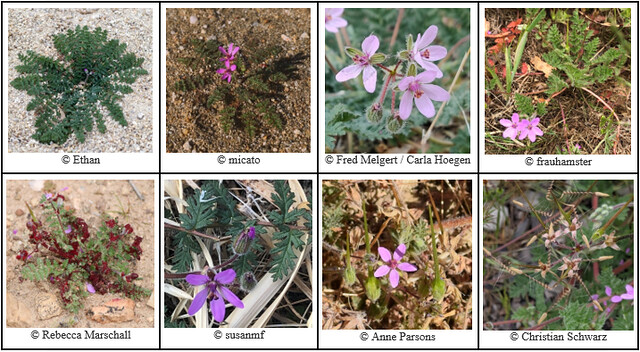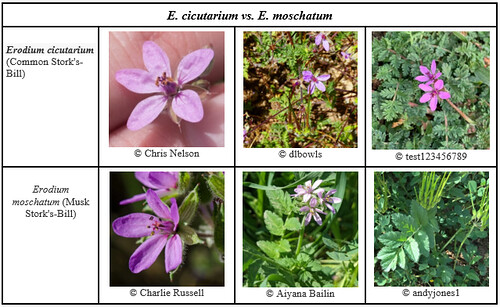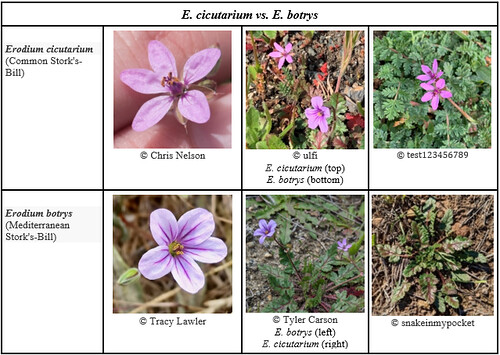How to identify Erodium cicutarium (Common Stork's Bill)
This project collects observations of Erodium cicutarium (Common Stork's-Bill) in California for the purpose of facilitating identification and preventing misidentification of this species in iNaturalist.
Photo tips:
- It’s important to get a picture of the entire plant.
- It's also helpful to get close-up pictures of the face of the flowers, sepals, leaves, and fruits, if present.
- If there are multiple plants in the picture, it’s helpful to crop your photo to focus on the plant of interest.
How to identify Erodium cicutarium:
- Stems: Slender red stems are hairy and sticky.
- Leaves are pinnate and compound, hairy and sticky. Leaflets are arranged on either side of the stem, typically in pairs opposite each other. Leaflets are deeply lobed or divided. Leaves or tips of leaflets are sometimes red. Erodium has red pigments naturally, so stress tends to bring out red coloration in this genus.
- Flowers come in shades of bright pink to purple. Petals are ovate and often have dark spots on the bases. The flowers are arranged in a loose cluster and have ten filaments (only five of which are fertile) and five styles. Sepals are 3‒5 mm long, equal to petals. Sepal tips are bristly.
- Fruit: The long hairless seed-pod, shaped like the bill of a stork, bursts open in a spiral when ripe, sending the seeds into the air. The pit of the fruit has 1 furrow below it.
- This plant is susceptible to infection by Stork's-bill Chytrid (Synchytrium papillatum), which can also make the leaves look red.
- Habitat: This is a very common invasive plant that can be found in open, disturbed areas, grassland, scrub.
- Peak blooming time: Feb‒Jun (per Calflora); Feb‒Sep (per Jepson eFlora)
Similar Species:
- Erodium moschatum (Musk Stork's-Bill)
- Erodium botrys (Mediterranean Stork's-Bill)
- Erodium malacoides (Soft Stork’s Bill)
How to differentiate E. cicutarium from E. moschatum:
- E. cicutarium stem is red and more slender; E. moschatum stem is green-white and thicker.
- E. cicutarium leaflets are deeply lobed or divided; E. moschatum leaflets are toothed or shallowly divided.
- E. cicutarium has fewer flowers in a loose cluster; E. moschatum typically has a larger number of flowers in an umbel shape.
- E. cicutarium has bristles on the sepal tips; E. moschatum does not.
- See this page for a helpful illustration: https://ucjeps.berkeley.edu/eflora/eflora_display.php?tid=25048
- This observation shows both species side-by-side. You can see they look very similar: https://www.inaturalist.org/observations/20952793
See these projects for thousands of examples of each species:
** https://www.inaturalist.org/projects/erodium-cicutarium-red-stemmed-filaree
** https://www.inaturalist.org/projects/erodium-moschatum-musk-stork-s-bill
How to differentiate E. cicutarium from E. botrys:
- Cool video: https://www.youtube.com/watch?v=_wZPewmNupk
- Both species can have red stems, so stem color is not helpful for differentiating these two species.
- E. botrys petals have dark purple streaks; E. cicutarium petals don’t.
- E. botrys flowers are larger and the petals are broader; E. cicutarium petals are narrower.
- One of the five E. botrys sepals always has a dark red stripe on its margins; E. cicutarium sepals don’t have the red stripe.
- E. botrys fruit beak is usually 7.5‒8.5 cm long, compared with 3.0‒3.5 cm long in E. cicutarium.
- E. botrys leaves are thicker, almost succulent; the leaves of E. cicutarium are finer.
- These two species often grow together in the same habitat.
Here's are some observations that shows the two species side-by-side:
** https://www.inaturalist.org/observations/19165993
** https://www.inaturalist.org/observations/47402200
** https://www.inaturalist.org/observations/71246645
** https://www.inaturalist.org/observations/71672569
** https://www.inaturalist.org/observations/40772820See these projects for many examples of each species:
** https://www.inaturalist.org/projects/erodium-cicutarium-red-stemmed-filaree
** https://www.inaturalist.org/projects/erodium-botrys-mediterranean-stork-s-bill
How to differentiate E. cicutarium from E. malacoides:
- E. cicutarium leaves are compound and leaflets are deeply dissected; E. malacoides leaves are large and simple.
- E. cicutarium sepals are pointed and bristly; E. malacoides sepal tips are rounded and bristly.
- E. cicutarium is very common; E. malacoides is still uncommon in California.
References:
- Calflora: https://www.calflora.org/app/taxon?crn=3448
- Jepson eFlora: https://ucjeps.berkeley.edu/eflora/eflora_display.php?tid=25041
- Monterey Wildflowers: https://montereywildflowers.com/geraniaceae-erodium/
- http://www.flora.sa.gov.au/cgi-bin/speciesfacts_display.cgi?form=speciesfacts&name=Erodium_cicutarium
- “Plants of the San Francisco Bay Region: Mendocino to Monterey”, Beidleman, Linda H. and Kozloff, Eugene N. (University of California Press, Berkeley, 2003)
- Eat the Weeds: Stork’s Bill, Cranesbill http://www.eattheweeds.com/erodium-circutarium-geranium-carolinianum-two-bills-you-want-to-get-2/
iNaturalist:
** How to identify Erodium cicutarium (Redstem Stork's-Bill)
** https://www.inaturalist.org/taxa/47687-Erodium-cicutarium
** Parent Project: https://www.inaturalist.org/projects/erodium-genus-stork-s-bills-california/
** https://www.inaturalist.org/projects/erodium-cicutarium-red-stemmed-filaree
** https://www.inaturalist.org/projects/erodium-seeds
** https://www.inaturalist.org/projects/erodium-phytopathology







